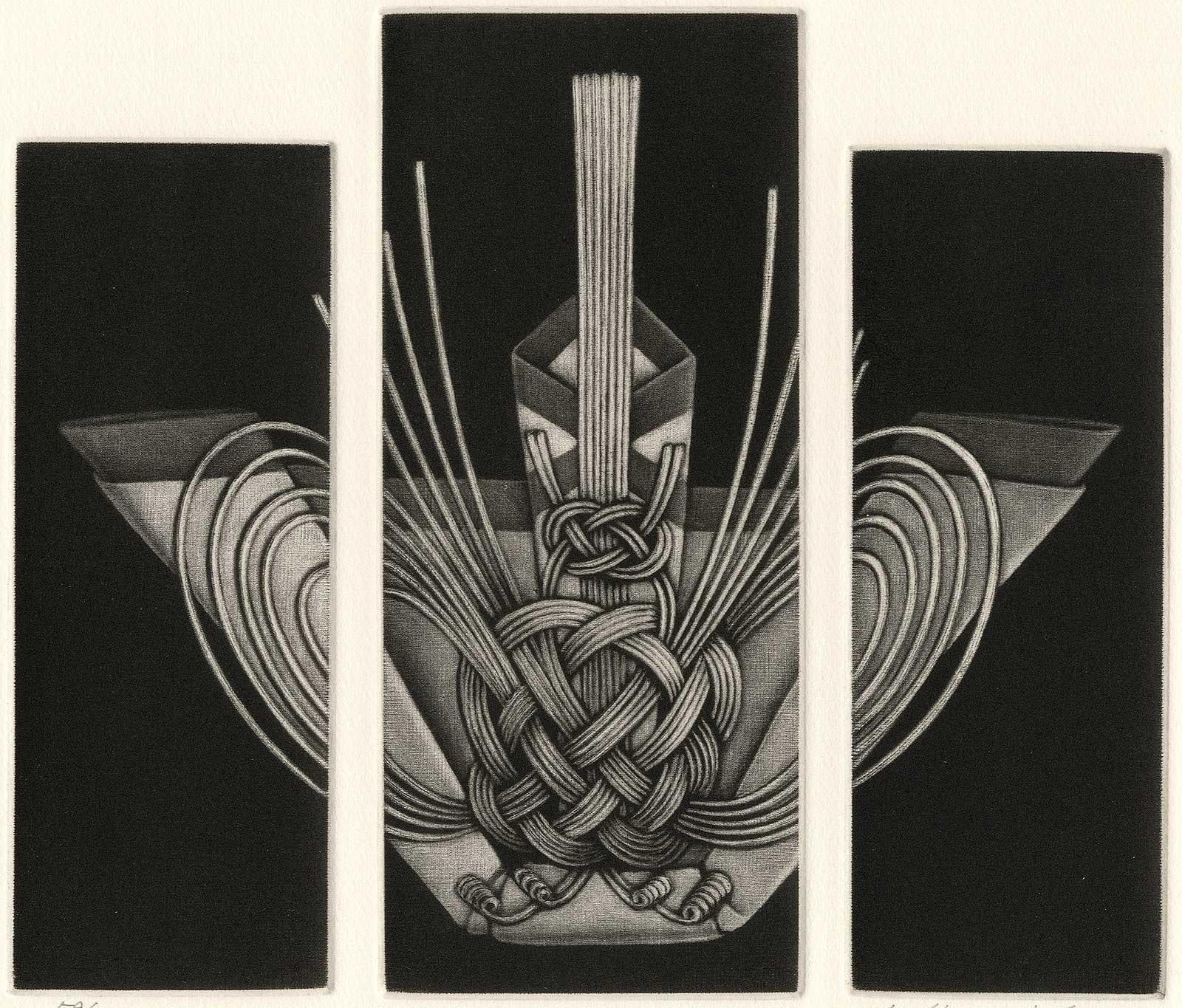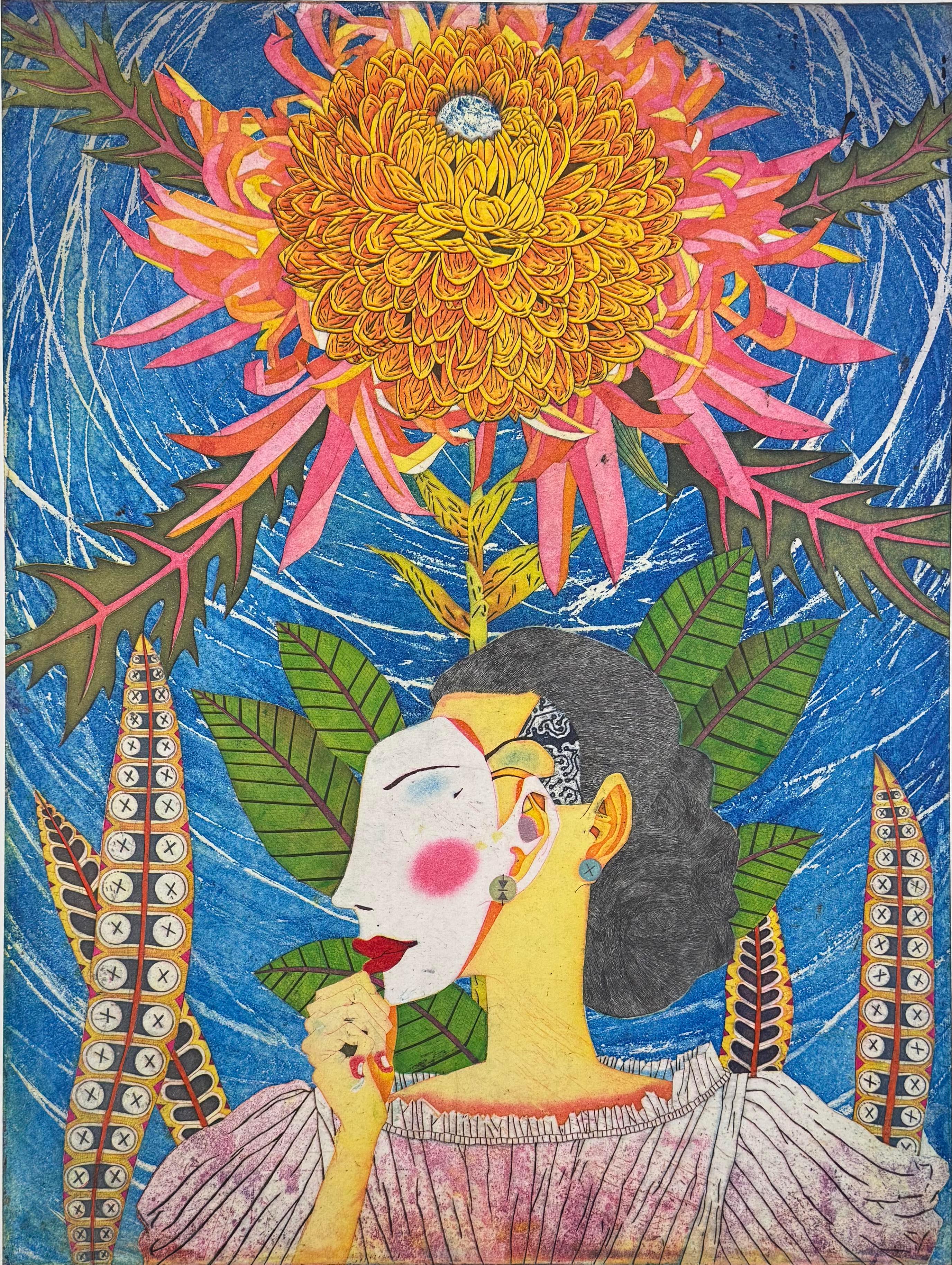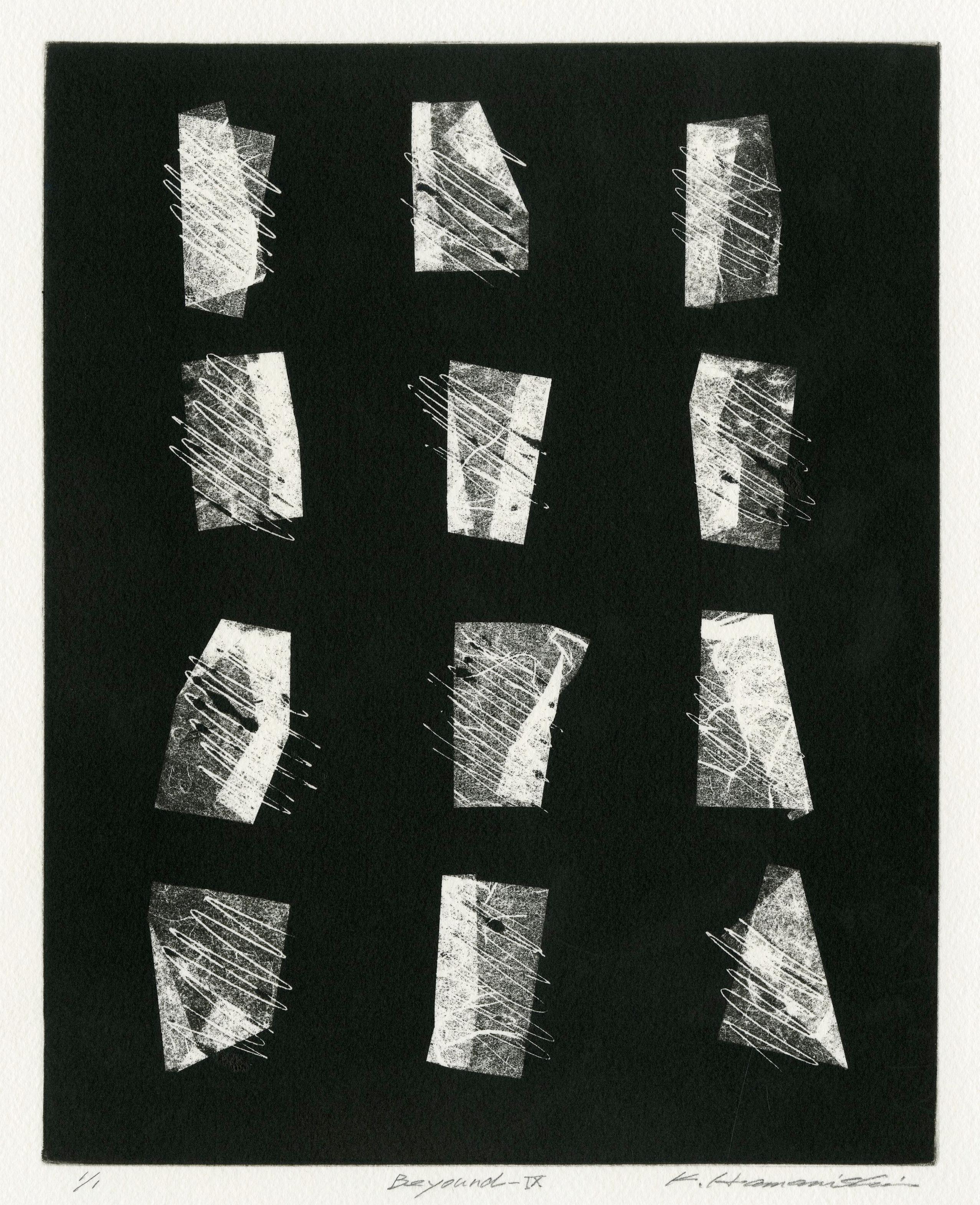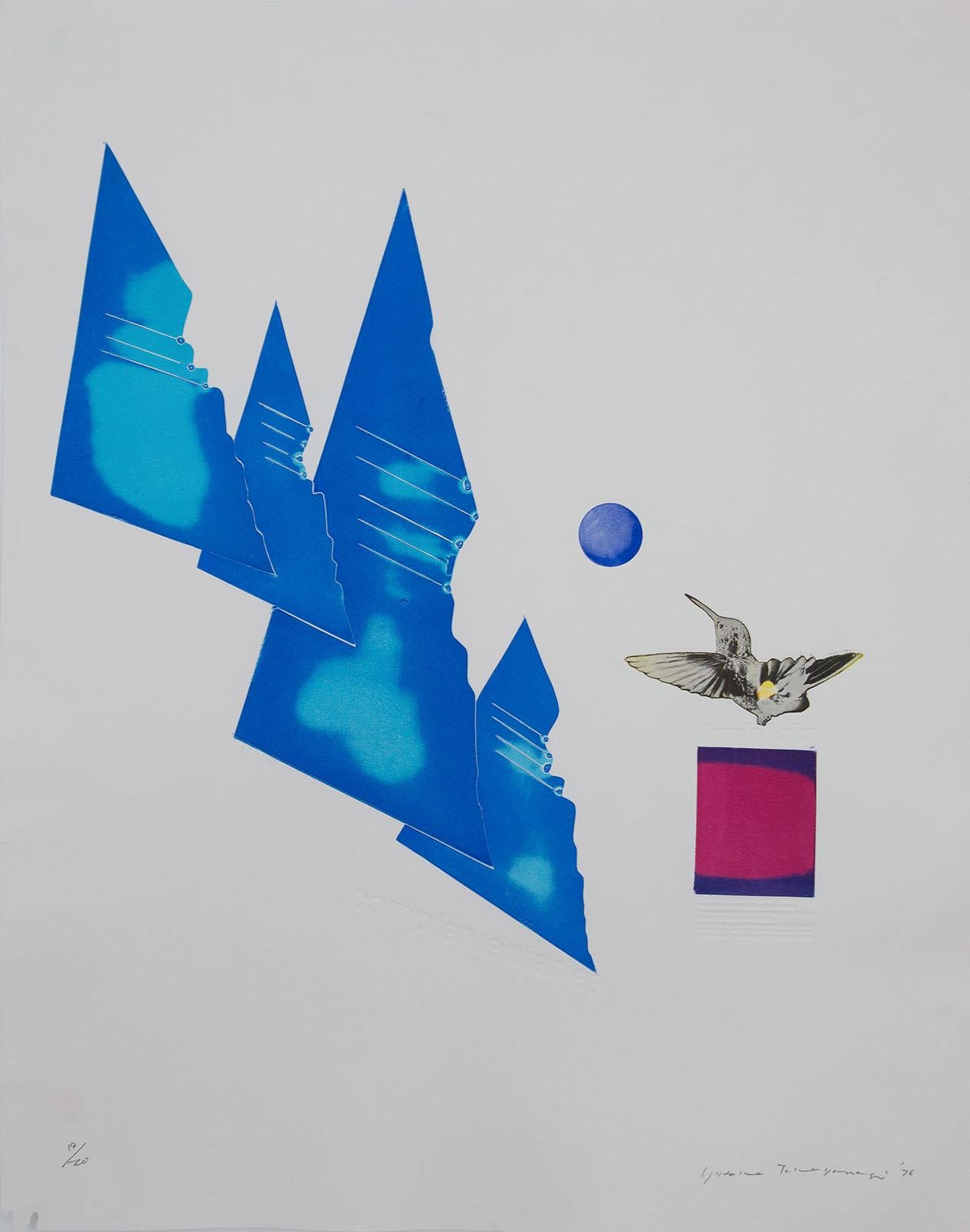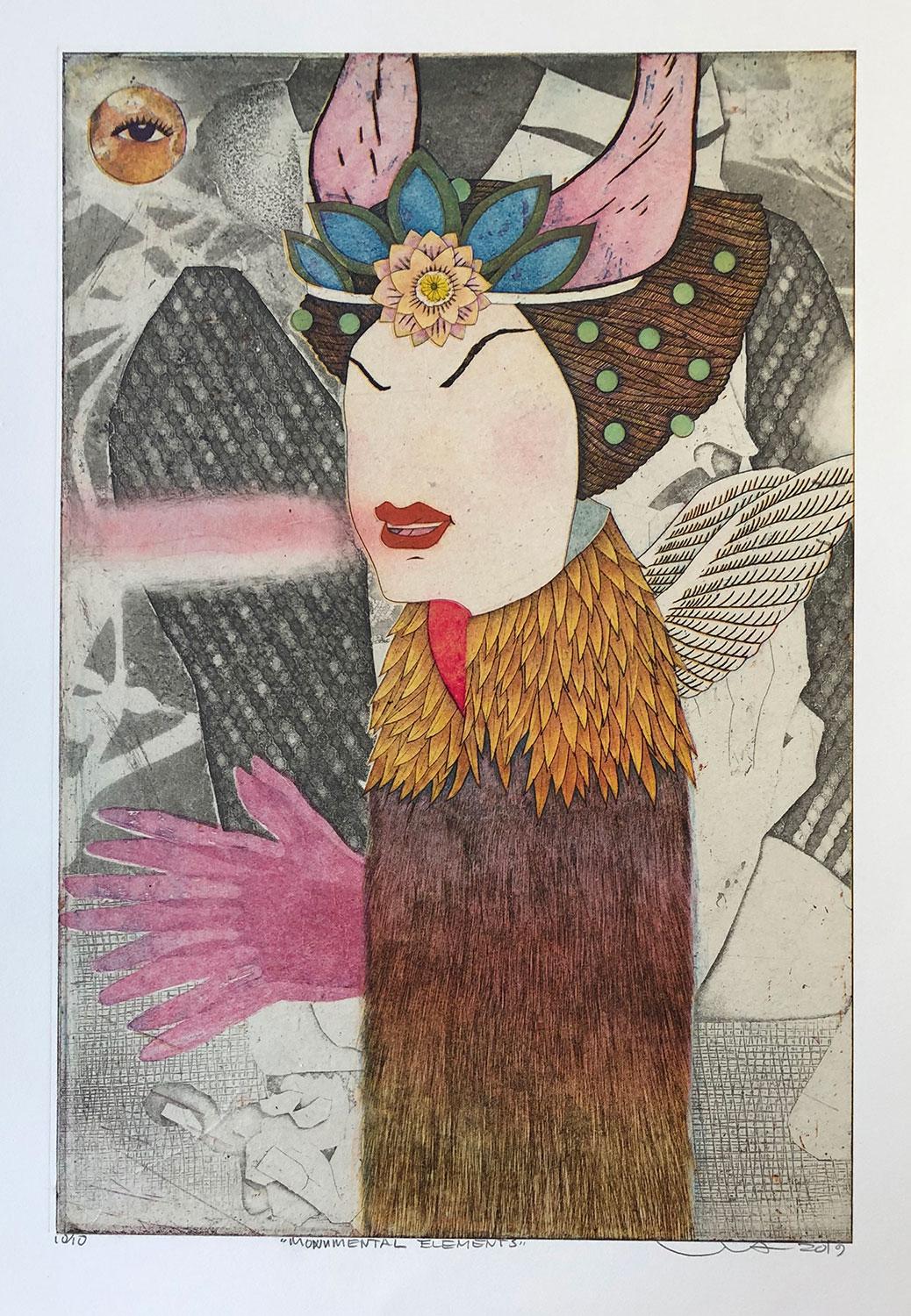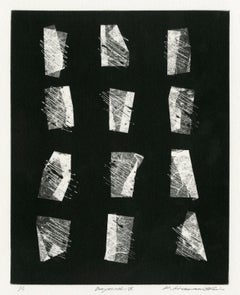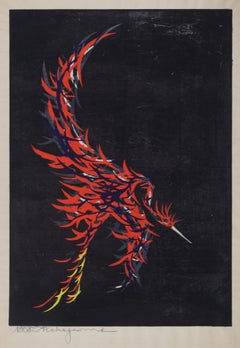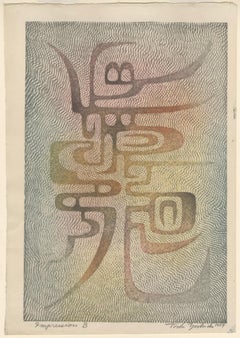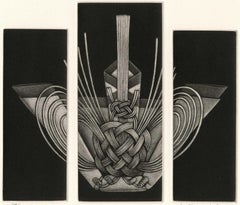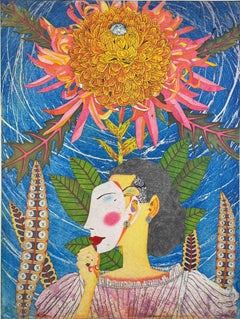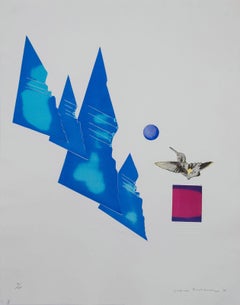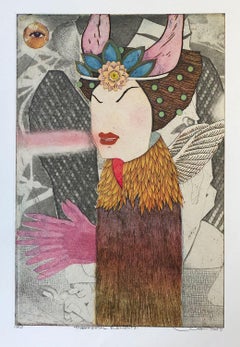Want more images or videos?
Request additional images or videos from the seller
1 of 14
Nakao MatsubaraXylon 21 Naoko Matsubara USA1970
1970
$950
£719.81
€825.92
CA$1,336.80
A$1,469.51
CHF 772.31
MX$17,845.26
NOK 9,634.37
SEK 9,127.89
DKK 6,164.05
About the Item
Xylon 21 Naoko Matsubara USA
Woodcuts, two which are printed in color, 1970
2 of the 5 woodcuts signed in pencil (see photos)
Five original woodcuts, two of which are signed in pencil
With introduction entitled Honest Pinetree by Frizt Eichenberg
The images are:
The Quaker’s Meeting, double page woodcut cover on grey/green paper, signed in pencil, with usual centerfold
Publisher: Sekton Schweiz de Xylon, Zurich
Date: August 1970
Edition: 500
Sylvan Snow, double page woodcut (with usual centerfold), signed in pencil, dedicated and dated, depicting a forest
Verso: Dragon, double page woodcut, with usual centerfold, depicting a dragon
Indian Dancer, double page woodcut in black and green (with usual centerfold), depicting dancer
Verso: Chinese Dancer. woodcut in red, depicting a dancer
Condition: Very good, usual handling issues for paper portfolio
Centerfolds as issued
Signle filio: 19 3/8 x 13 1/2 inches
Double folio: 19 3/8 x 27 inches
Publisher: Sekton Schweiz de Xylon, Zurich
Date: August 1970
Edition: 500
Provenance: Amity Art Foundation, Inc.
A rare dedicated example with a dedication in pencil “For Frank” and dated 1970
Note: Matsubara graduated from the Kyoto University of Applied Arts in 1960. She then pursued an MFA in the School of Fine Arts at the Carnegie Mellon University in Pittsburgh on a Fulbright Travel Grant, and since then has traveled extensively and taught at the Pratt Institute in Brooklyn—a rare distinction for a Japanese woman. She also studied one year at the Royal College of Art, London. Currently she lives and works in Oakville, Canada.
Naoko Matsubara’s style is influenced by her teacher Munakata Shiko (1903–1975), who worked in the mingei (folk art) tradition. Her works are part of the collections of many museums around the world such as the Philadelphia Museum of Art, the Chicago Art Institute, the Royal Ontario Museum, the Albertina in Vienna, the British Museum in London, the Kyoto National Museum of Modern Art, the Museum of Fine Arts, Boston, the Tokyo National Museum of Modern Art, the Smithsonian Institution and the Library of Congress in Washington, the Hamburg Museum of Arts and Crafts, the Haifa Museum in Israel and the Art Gallery of New South Wales in Sydney. She was made a member of the Royal Canadian Academy of Arts.
(Courtesy of Wikipedia)
Naoko Matsubara (1937 - )
Matsubara Naoko (松原直子) was born in 1937 on Shikoku Island into an old Shinto family, and grew up in Kyoto, where her father was a senior priest. She was educated at the Kyoto Academy of Fine Art (BFA, 1960); and was a Fulbright Scholar at what is now Carnegie Mellon University, Pittsburgh (MFA, 1962). She was also a Special Invited Student at the Royal College of Art in London (1962).
After travelling extensively in Europe and Asia, Naoko Matsubara returned to Japan for two years, before being lured back to the United States. There she worked as personal assistant to the late Prof. Fritz Eichenberg, and also taught at the Pratt Institute of Graphic Art in New York, as well as at the University of Rhode Island. Subsequently she lived in Cambridge, Mass.
In 1972 Naoko Matsubara moved to Canada, and now lives in Oakville, Ontario. She has continued to be extremely active as an artist: locally, nationally and internationally. Since 1960 she has had some 75 solo exhibitions, in the USA, Canada, Japan, England, Ireland, Germany, Austria, Switzerland, Holland and Mexico. She has also participated in numerous group exhibitions.
Public collections owning work by Naoko Matsubara include: Albertina, Vienna; Art Institute of Chicago; British Museum; Carnegie Institute; Museum für Kunst und Gewerbe, Hamburg; Museum of Fine Arts, Boston; Philadelphia Museum of Art; Cincinnati Art Museum; Detroit Institute of Art; Fogg Art Museum, Harvard University; Haifa Museum, Israel; Kyoto National Museum of Modern Art; Royal Ontario Museum; The White House, Washington DC; Tokyo National Museum of Modern Art; Yale University Art Gallery.
Naoko Matsubara has published some 20 books and portfolios of her work, including most recently Tibetan Sky (Calgary: Bayeux Arts Publishers, 1997; Preface by the Dalai Lama); Tokonoma (Bath, England: Old School Press, 1999); and Konjaku monogatari (Tokyo: ALIS, 2002). Her work also includes a large mural and donor pillar for the new YMCA building in Oakville, Ontario (2003); mixed-media screens; and paintings. In 2005, the Royal Ontario Museum commissioned two large works from Naoko Matsubara for the Museum's Bloor Street window case. The artist generously donated a third work, Emerald Summer (2006). The three works (each 195 cm. high by 95 cm. wide) will be rotated at regular intervals into the outside window. This is the first commissioned artwork to be displayed on the Museum’s Bloor Street Plaza.
Recent major exhibitions have been in Tokyo, Kyoto, Indiana, and Toronto (Royal Ontario Museum). Further exhibitions are currently being planned in Seattle and Tokyo; new books in process include In Praise of Hands. She also continues to travel widely; is frequently invited to speak about her work; and also publishes essays, in both English and Japanese.
Naoko Matsubara’s work has been the subject of countless articles and reviews; documentary films (including two from the Canadian Broadcasting Corporation); and several book-length publications: notably Mokuhan: The Woodcuts of Munakata and Matsubara (text by Joan Stanley-Baker; Victoria, BC: Art Gallery of Greater Victoria, 1976); Naoko Matsubara: Development of Artistic Style and Technique (text by Barbara Woodworth; MFA thesis, Harvard University, 1985);.and Tree Spirit. The Woodcuts of Naoko Matsubara (text by Arlene Gehmacher, Klaas Ruitenbeek and John M. Rosenfield; Toronto: Royal Ontario Museum, 2003).
In May 2009, Ms. Matsubara received an honorary doctorate in Fine Arts from Chatham University in Pittsburgh.
Courtesy: Carnegie Mellon University], Alumni press release of 11/2010, accessed 8/3/11
About the Seller
5.0
Recognized Seller
These prestigious sellers are industry leaders and represent the highest echelon for item quality and design.
Platinum Seller
Premium sellers with a 4.7+ rating and 24-hour response times
Established in 1978
1stDibs seller since 2013
813 sales on 1stDibs
Typical response time: <1 hour
Associations
International Fine Print Dealers Association
- ShippingRetrieving quote...Shipping from: Akron, OH
- Return Policy
Authenticity Guarantee
In the unlikely event there’s an issue with an item’s authenticity, contact us within 1 year for a full refund. DetailsMoney-Back Guarantee
If your item is not as described, is damaged in transit, or does not arrive, contact us within 7 days for a full refund. Details24-Hour Cancellation
You have a 24-hour grace period in which to reconsider your purchase, with no questions asked.Vetted Professional Sellers
Our world-class sellers must adhere to strict standards for service and quality, maintaining the integrity of our listings.Price-Match Guarantee
If you find that a seller listed the same item for a lower price elsewhere, we’ll match it.Trusted Global Delivery
Our best-in-class carrier network provides specialized shipping options worldwide, including custom delivery.More From This Seller
View AllBeyound (sic) - IX
By Katsunori Hamanishi
Located in Fairlawn, OH
Beyond (sic) - IX
Mezzotint, n.d.
Signed, titled and numbered in pencil (see photos)
Edition: Unique impression (i/I)
Ninion and Sheldon Landy were major collectors of Hamanishi's works. They donated a large group of his mezzotints to Art Institute of Chicago, which formed the core of the exhibitions of his works at AIC in 2014 and again in 2019.
Condition: excellent
Plate/Image size: 9.75 x 7.75 inches
Sheet size: 12 1/2 x 9 5/8 inches
Provenance: Ninion and Sheldon Landy, Hamanishi's patrons
EXTREMELY RARE-UNIQUE
Katsunori Hamanishi
Born: 1949, Hokkaido
Medium: Mezzotint, with relief printing and metallic foil. Also a few woodblocks
Hamanishi studied painting and graduated from Tokai University with a degree in Art, in 1973. Since then, he has been living in the Tokyo area, where his primary focus is printmaking. Mezzotint is a variation of intaglio printing--an exacting and laborious process whereby ink is transferred from below the surface of the plate by use of a press. First, the entire copper plate is indented with a toothed steel rocker tool. Worked in all directions, this creates an even finely-grained texture over the surface of the plate. Each pit will hold ink and were the plate inked at this stage, it would print almost solid black.
To create the design the artist smoothes out some of the pits with a burnisher so they will hold less ink. Where highlights are required the plate is burnished and polished quite smooth. A wide range of tones are possible in mezzotint and the process can usually be recognized by a light design on a velvety black background. Hamanishi is internationally known for his mastery of this medium. He creates images with both subtle detail and dynamic composition that explore spatial relationships.
His genius is in balancing calm and meditative qualities with the energetic tensions of inanimate and natural objects. Early work had such things as pipes and branches wrapped with cloth, later rope, then straw. When he moved to a more rural area, rice fields became a common element. He has also been exploring the use of color and metallic leaf in his artwork. In 2005 Mr. Hamanishis began the Haze series exploring more abstract themes using the subtle differences between matte and black inks done in mezzotint and relief printing.
There is always a sense of mystery and intrigue in the complex mezzotint prints that come from Hamanishi’s deft hands. They compel the viewer to do a slow, thoughtful examination in order to fully absorb the vision the artist intends.
Exhibitions:
Worcester Art Museum, Massachusetts --2 person show with Hamaguchi
Ibiza Biennial, Spain--Grand Prize
Original Colored Graphic Print Triennial, Switzerland--Grand Prize
Cabo Frio International Print Biennial, Brazil--Grand Prize
CWAJ Print Show, Tokyo--Art Grant winner
Republic of China Print Exhibit--Gold Medal
Graphic Arts Council, Achenbach Foundation, San Francisco--commissioned print
Art Institute of Cleveland
University of Alberta, Edmonton, Canada--visiting artist
Shun-yo-Kai, Tokyo--prize winner
Bhara Bhavan International Print Biennale, India
Ren Brown...
Category
1980s Abstract Abstract Prints
Materials
Mezzotint
Keshin (Incarnation (Moku)
Located in Fairlawn, OH
Keshin (Incarnation (Moku)
Color woodcut, 1958
Signed and dated lower left in pencil (see photo)
An impression is in the collectionof the Asian Art Museum, No. 2012.93, which is not a richly inked s this impression.
Another impression is in the National Museum of Art, Smithsonian, accession no. S2019.3.1297
A third impression is in the collectionof the Art Gallery of Greater Victoria
This appears to be the best and most colorful impression of the museum holdings.
The image is thought to depict a flying crame
Condition: Wrinkles to large sheet of handmade paper. Not objectionable.
Image size: 29 15/16 x 21 1/4 inches
Sheet size: 37 3/8 x 27 1/4 inches
Reference: Tadashi Nakiyama Life & Work, Plate F
Tadashi Nakayama - Sosaku hanga artist Tadashi Nakayama initially studied oil painting at Tama Art College, but began creating woodblock prints in 1951. In the 1960s, he traveled to Turkey, Greece, England, and Italy, absorbing influences from Persian and Byzantine art and the renaissance master Paolo Ucello. Throughout his long career, his subjects have included flowers, butterflies, women, and perhaps most famously, horses...
Category
1950s Abstract Abstract Prints
Materials
Woodcut
No Footprints Show, Where the Flowers Grow Deep
By Shiko Munakata
Located in Fairlawn, OH
No Footprints Show, Where the Flowers Grow Deep
Woodcut, 1961
Unsigned (as isssued)
From: The "Way" of the Woodcut, three woodcuts, 1961
Publisher: Pratt Adlib Press, Brooklyn, New Y...
Category
1960s Modern Figurative Prints
Materials
Woodcut
Impression B
By Toshi Yoshida 1
Located in Fairlawn, OH
Impression B
Color woodcut, 1959
Signed and dated lower right (see photo)
Titled lower left (see photo)
A trial proof, prior to the edition of 100, signed and numbered
Condition: Excellent
Image size: 14 1/2 x 9 3/4 inches
Provenance: Estate of the artist
by decent to his heirs
"Printmaker and painter Toshi Yoshida was born on July 25, 1911, into the respected Yoshida family of artists of Tokyo, Japan. Father Hiroshi was a celebrated landscape painter and printmaker, and mother Fujio established herself as the first female Yoshida artist as well as an Abstract artist later in her career. Younger brother Hodaka was an Abstract printmaker whose style, completely separate from his family's historic traditional bent, later influenced Toshi. Hodaka's wife Chizuko would become a pioneering female Japanese artist whose own exploration of Surrealism and Abstraction challenged the status quo. Toshi, however, as the eldest sibling, was expected to follow in his father's footsteps, and from an early age he was trained by Hiroshi in his studio.
Unable to attend formal schooling due to the polio-induced paralyzation of his leg, Toshi would instead help with his family's printmaking studio and go on sketching trips with Hiroshi. As he got older, these trips would include India and Southeast Asia, working from morning to night taking night trains to get from one destination to another. Among Toshi's favorite subjects were the animals he discovered along the way. However, these trips ended as Japan entered military dictatorship in the mid 1930s, and artists whose work showed signs of Western influence were barred from exhibiting. At this time, Toshi left Japan for China and Korea, where he would remain for the duration of the war. He stuck to patriotic themes to remain in business, and after the end of World War II, as Japan struggled to recover from wartime economic depression, he earned his living creating traditional Japanese woodcut landscapes...
Category
1950s Abstract Abstract Prints
Materials
Woodcut
Impression B
By Toshi Yoshida 1
Located in Fairlawn, OH
Impression B
Color woodcut, 1959
Signed and dated lower right (see photo)
Titled lower left (see photo)
A trial proof, prior to the edition of 100, signed and numbered
Condition: Excellent
Image size: 14 1/2 x 9 3/4 inches
Provenance: Estate of the artist
by decent to his heirs
"Printmaker and painter Toshi Yoshida was born on July 25, 1911, into the respected Yoshida family of artists of Tokyo, Japan. Father Hiroshi was a celebrated landscape painter and printmaker, and mother Fujio established herself as the first female Yoshida artist as well as an Abstract artist later in her career. Younger brother Hodaka was an Abstract printmaker whose style, completely separate from his family's historic traditional bent, later influenced Toshi. Hodaka's wife Chizuko would become a pioneering female Japanese artist whose own exploration of Surrealism and Abstraction challenged the status quo. Toshi, however, as the eldest sibling, was expected to follow in his father's footsteps, and from an early age he was trained by Hiroshi in his studio.
Unable to attend formal schooling due to the polio-induced paralyzation of his leg, Toshi would instead help with his family's printmaking studio and go on sketching trips with Hiroshi. As he got older, these trips would include India and Southeast Asia, working from morning to night taking night trains to get from one destination to another. Among Toshi's favorite subjects were the animals he discovered along the way. However, these trips ended as Japan entered military dictatorship in the mid 1930s, and artists whose work showed signs of Western influence were barred from exhibiting. At this time, Toshi left Japan for China and Korea, where he would remain for the duration of the war. He stuck to patriotic themes to remain in business, and after the end of World War II, as Japan struggled to recover from wartime economic depression, he earned his living creating traditional Japanese woodcut landscapes...
Category
1950s Abstract Abstract Prints
Materials
Woodcut
Combination-Cross No. 3
By Katsunori Hamanishi
Located in Fairlawn, OH
Combination-Cross No. 3
Mezzotint, 1979
Signed, titled and numbered in pencil
Edition: 30 (9/30)
Provenance: Ninion and Sheldon Landy, Chicago
The Landy's donated a large collection of Hamanishi to the Art Institute of Chicago in 2013, which formed the core of the exhibitions of his works at AIC in 2014 and again in 2019.
Condition: Excellent
Image size: 13 5/8 x 14 1/8 inches
HAMANISHI Katsunori...
Category
1970s Contemporary Abstract Prints
Materials
Mezzotint
You May Also Like
Mizuhiki
By Katsunori Hamanishi
Located in New Orleans, LA
"Mizuhiki" is an exclusive publication by Stone + Press in an edition of 100.
Katsunori Hamanishi was born in 1949 on Hokkaido island - Japan's second largest island. In 1973 he fi...
Category
1990s Contemporary Abstract Prints
Materials
Mezzotint
CN 31773
By Yuji Hiratsuka
Located in Palm Springs, CA
"CN 31773" merges botanical motifs with the human form, reflecting the artist’s ongoing exploration of the interconnectedness between people and their environments. The title refers ...
Category
2010s Contemporary Figurative Prints
Materials
Intaglio
Complementaries
Located in Llanbrynmair, GB
’Complementaries’
By Yutaka Takayanagi.
Medium - Relief and lithographic print
Edition - 19/20
Signed - Yes
Size - 615mm x 780mm
Date - 1976
Condition - Good. 9 out of 10.
Born in Tokyo in 1941, Takayanagi's artistic journey began when he enrolled at Tokyo University of the Arts in 1960, studying under the renowned oil painter Kaoru Yamaguchi. His talent was quickly recognized when he received an Honorable Mention at the 8th Shell Arts Award Exhibition in the same year.
During his time at university, Takayanagi took an intensive course in copper plate printing under Tetsuro Komai, receiving his degree from the graduate school in 1966. Fascinated by the simultaneous color print method, he started creating copperplate prints and soon gained recognition for his unique metallic reliefs, which he produced using collages of English newspapers.
Takayanagi's passion for experimentation led him to create metallic emboss reliefs using his own photographs, and in the latter half of the 1980s, he moved on to silkscreen prints. He continued to push the boundaries of his art, constantly exploring new techniques and mediums.
In 1978 and the following year, Takayanagi was appointed as an arts researcher for the Ministry of Culture and traveled to the United States, France, and the UK. These experiences enriched his artistic perspective and further cemented his reputation as a highly regarded artist.
Takayanagi was part of the influential printmaking group Sosaku Hanga, which emerged in the early 20th century in Japan. This movement emphasized the artist's involvement in every stage of the printmaking process, from designing the image to carving and printing the blocks.
Takayanagi's work often incorporates elements of nature and landscape, with an emphasis on texture and pattern. He also experimented with collage, incorporating found materials like newspaper clippings and photographs into his prints.
Takayanagi's work has been exhibited extensively in Japan and internationally, including at the Museum of Modern Art in New York and the National Museum of Modern Art in Tokyo. He has also received numerous awards for his contributions to printmaking, including the Japan Print Association Award and the Purple Ribbon Medal...
Category
1970s Abstract Abstract Prints
Materials
Lithograph
$428 Sale Price
20% Off
Monumental Elements
By Yuji Hiratsuka
Located in Palm Springs, CA
Signed, titled and numbered from an edition of 20.
While the images have some resemblance to traditional Japanese Ukiyo-e prints, their sense of whimsy, satire and irony relate more...
Category
2010s Contemporary Still-life Prints
Materials
Intaglio
Bio Multiverse
By Yuji Hiratsuka
Located in Palm Springs, CA
Hiratsuka’s focus on the coexistence of Eastern and Western influences, as well as his use of satire, irony, and ambiguity, invites viewers to reflect on the complexity of modern ide...
Category
2010s Contemporary Figurative Prints
Materials
Intaglio
Non Stop Laining for the decadent tomorrow, Screenprint by Futaba Ando
Located in Long Island City, NY
Non Stop Laining for the decadent tomorrow
Futaba Ando, Japanese
Date: 1972
Hand colored Screenprint on wove paper, signed, titled, numbered, and dated in pencil
Edition of EP
Image ...
Category
1970s Contemporary Figurative Prints
Materials
Screen
More Ways To Browse
Used Museum Cases
Emerald Collection Made In China
Chinese Dancer
Used Casement Window
Quaker Meeting
Christ And The Rembrandt
Christian Silvain
Clemens Briels On Sale
Collier Picasso
Corneille Bleu
Cristina Martinez
Dali Alice In Wonderland
Dali Aliyah
Dali Apollinaire
Dali Cleopatra
Dali Fisherman
Dali Freud
Dali Historical Heritage
